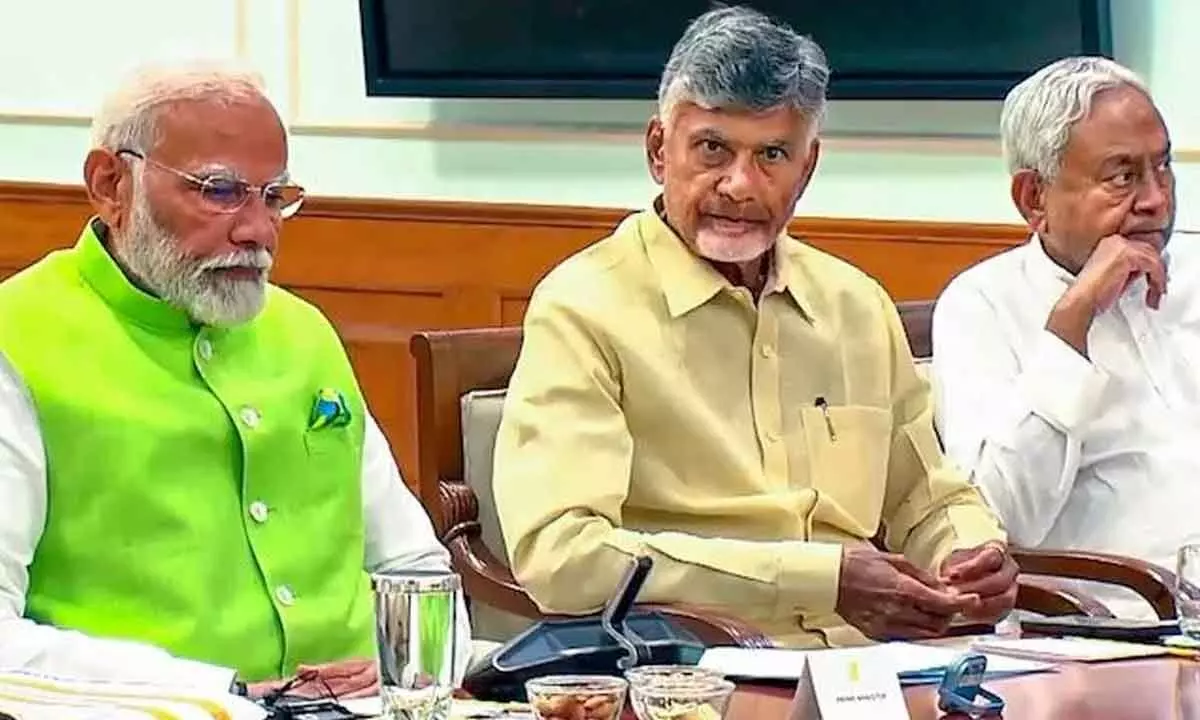Live
- IPL 2025 Auction: Ravichandran Ashwin, Rachin Ravindra return to Chennai Super Kings
- Manipur: After over a week's closure, regular classes to resume in educational institutions
- Govt open to discuss all issues, says Kiren Rijiju on eve of Winter Session of Parliament
- Pakistan reports three new polio cases, 2024 tally reaches 55
- Multifold Increase in migratory bird population at TN bird sanctuary
- Archaka Maha Sabha in Jogulamba Gadwal District Highlights Key Demands for Priests' Welfare
- IPL 2025 Auction: Both Rahul and Starc are world-class players, says Delhi Capitals head coach Badani
- Committed to the Welfare of Brahmins - MLA Kuchukulla Rajesh Reddy
- MLA Shri Ganesh Participates in Maha Sudarshana Homam and Srinivasa Kalyanam in Secunderabad
- Terror hideout busted in J&K's Kupwara district
Just In
Will the marriage of unlike minds last?


A SWOT – Strengths, Weaknesses, Opportunities and Threats - analysis of NDA’s survivability, indicates that since the BJP is likely to be more accommodative in its relationship with allies unlike the practice in the previous two terms – more because of its’ own below majority mark, than any altruistic intent – the alliance can last its full term i.e., if there are no skirmishes between any of its major allies over policy and power sharing issues
During the earlier two terms of the NDA governance at the Centre, the BJP allies were reduced to insignificance with little or no role in the decision-making process. The BJP, due to their majority in the parliament, had subjugated its partners to a status of non-entities. The allies on their part also did not mind playing second fiddle, since being part of the ruling clique, in itself, meant a plethora of power-packed benefits and privileges.
Now, with the BJP lacking the numbers to form the government on its own and dictate terms, the NDA combine may in all probability present a parody of paradoxes. The changed equations can induce reversal of roles, with the BJP playing to the tunes of the TDP, Janata Dal United (JDU) and others. The BJP-dominated NDA in its ten-year tenure – 303 out of 353 in 2019 and 282 out of 336 in 2014 - had passed and imposed a slew of contentious bills and policies – most of them in accordance with their ideological agendas and propensities – with an outnumbered opposition crying hoarse and an equally hapless allies remaining mute participants in the process.
Though the Modi-led NDA has taken over the reins, speculations persist about the durability of the coalition government. Questions about NDA’s survival are making the rounds due to the fragile equations within the alliance. Such doubts about longevity can also be attributed to the rejuvenation of the India Bloc partners.
The Indian political history is replete with antecedents of marriages between political incompatibles inevitably leading to divorce. Despite such precedents, it cannot be presumed that ‘Birds of different feathers can never flock together” and that those with different plumages may desert the flock in quest of greener pastures.
A SWOT – Strengths, Weaknesses, Opportunities and Threats - analysis of NDA’s survivability, indicates that since the BJP is likely to be more accommodative in its relationship with allies unlike the practice in the previous two terms – more because of its’ own below majority mark, than any altruistic intent – the alliance can last its full term i.e., if there are no skirmishes between any of its major allies over policy and power sharing issues. The cooperation of all alliance partners – both big and small – is now a necessity for the existence of the government, and the BJP is conscious of their importance in ensuring its own survival. This equation translates into empowerment of NDA allies to enforce checks and balances and apply brakes against imposition of ideology-driven policies and legislations.
In terms of Opportunities, the allies, specifically AP Chief Minister Chandrababu Naidu of the TDP and Bihar Chief Minister of JDU would prefer to be part of the power centre, to ensure bargaining advantage for their respective states. For the TDP, the BJP with its 240 seats ensures durability and stability vis-à-vis the India Bloc comprising congress with 99 seats, and other splintered entities which can be susceptible to irresistible temptations for changing their loyalties. Since all these opportunities can create a win-win situation for all the partners in NDA, there is a strong possibility of the coalition traveling the full distance.
The biggest threat to the existence of the NDA may not be posed by the Parties in the alliance, but their MPs who would also demand their Shylockian slice. There are many such characters in all the parties – without exception – who have an ingrained tendency to succumb to temptations and migrate to opposition camps. In fact, the 20 turncoat MPs in the present BJP could prove to be the biggest threat and weakness for the party and the alliance government.
The BJP comprises closely knit cadre with strong brand and ideological loyalty. There is no “guarantee” that these defectors could tag along with the NDA till the logical end. The possible turnaround by the 20-odd turncoats can create a huge dent in its numbers and reduce the BJP strength to 220 seats. Inevitably, there could be potential threats, but the overall analysis indicates continuance of the NDA government - despite the hassles within - since India Block - despite its narrow difference - can also prove to be too brittle to be considered as an alternative by the wall sitters.
(The writer is a senior print, electronic and digital media journalist)

© 2024 Hyderabad Media House Limited/The Hans India. All rights reserved. Powered by hocalwire.com






